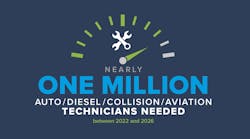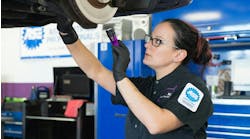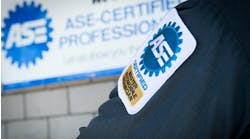Dropping technician numbers may become problem for shops
Even before the pandemic, there was a technician shortage. Some estimates say the industry, which includes every segment from automotive to aviation, will need more technicians in the next four years than we have available in the pipeline.
What does that mean?
According to the Techforce Foundation, a non-profit group helping replenish the supply of technicians to shops that desperately need them, the industry may require almost one million new technicians by 2026.
TechForce recently released its 2022 Transportation Technician Supply & Demand Report that shows program graduates (completions) slipped 2.6% and 0.4% in the diesel and collision repair segments but have fallen by a combined 17% over the past five years.
Even with a solid year-over-year rebound in employment for automotive (+4.2%) and diesel (+6.5%) repair segments, the overall picture shows a drop in combined completions, going from 48,208 in 2020 to 44,052 in 2021. Collision repair techs have also dropped 0.7%, continuing a six-year decline.
At the heart of the issue, TechForce estimates demand for new automotive/diesel/collision repair technicians (new and replacements from prior years) will reach 232,000 in 2022 and balloon to 900,000 through 2026. That big number will need to be filled in just four years.
A recent article in WIRED magazine highlighted the issue of fewer shops to repair high-tech cars and fewer independent shops capable of working on these vehicles. The article states that U.S. repair shops fixed 246 vehicles per bay in 2020, compared to 225 in 2016.
The problem growing under our noses is the amount of expert, specialized knowledge, and expensive tools required to do the job. And in many cases, independent shops can't get all the necessary repair information to do the job correctly. Without expert techs who know how to use high-tech tools and think like engineers, some shops are reluctant to work on a vehicle if they know they can't do it right. So they send the job to the dealership. But even dealerships need help hiring techs.
The issue of repairing vehicles in a timely and affordable manner has worsened. According to WIRED, it took an average of 2.1 days longer to fix a car in 2021 than in 2019; and nearly 11 days overall on average. Some experts suggest that getting a vehicle repaired in the future (10 years from now) will require the vehicle owner to travel significantly farther to find a shop to do the work (especially for late-model cars).
The state of the repair industry should matter to tool distributors as much as it does to shops. How far will you have to drive to service the same number of accounts? What about the number of customers (i.e., techs) purchasing tools from you week after week?
It helps to take a glass-half-full approach, according to TechForce Foundation CEO Jennifer Maher.
"The solution to this crisis lies in industry, non-profit, education, and government partners working together to build awareness, curiosity, and interest in these careers among our youth," said Maher. "This year's report underscores the challenges we face in attracting, training, and retaining technicians and the boundless opportunities for talented young people to build successful, rewarding careers in one of the world's most dynamic and technology-intensive industries."
This article originally appeared on VehicleServicePros.com.




